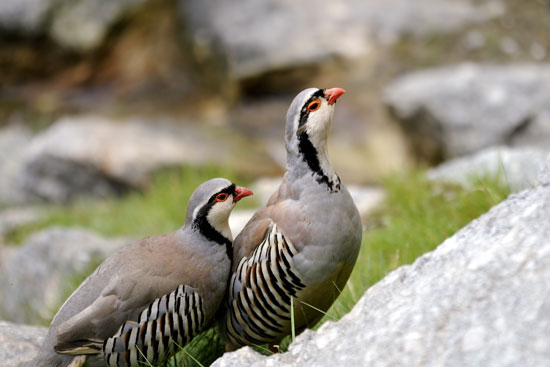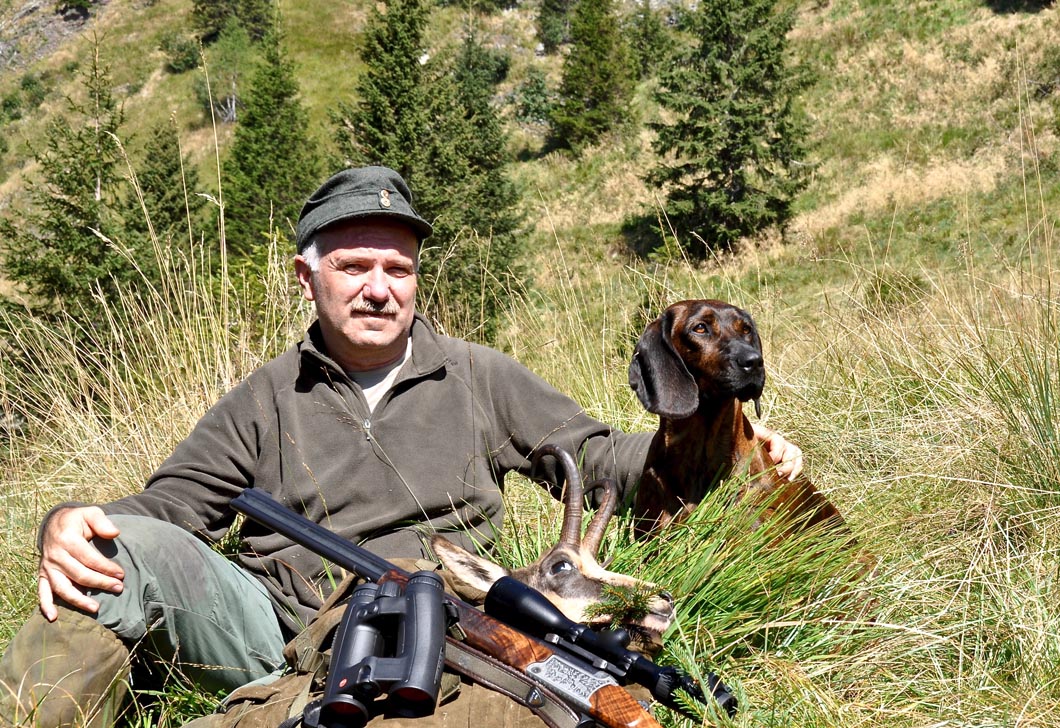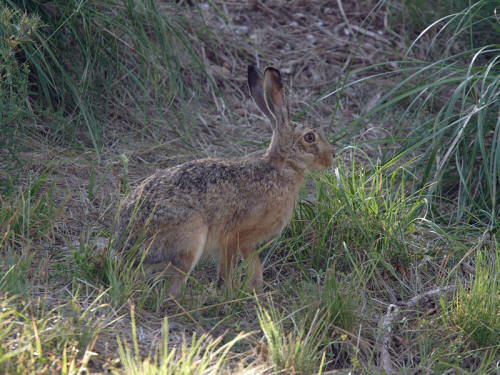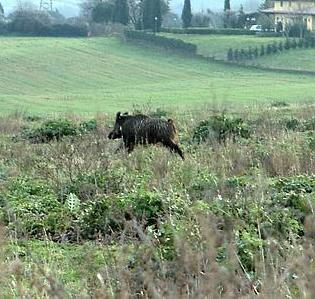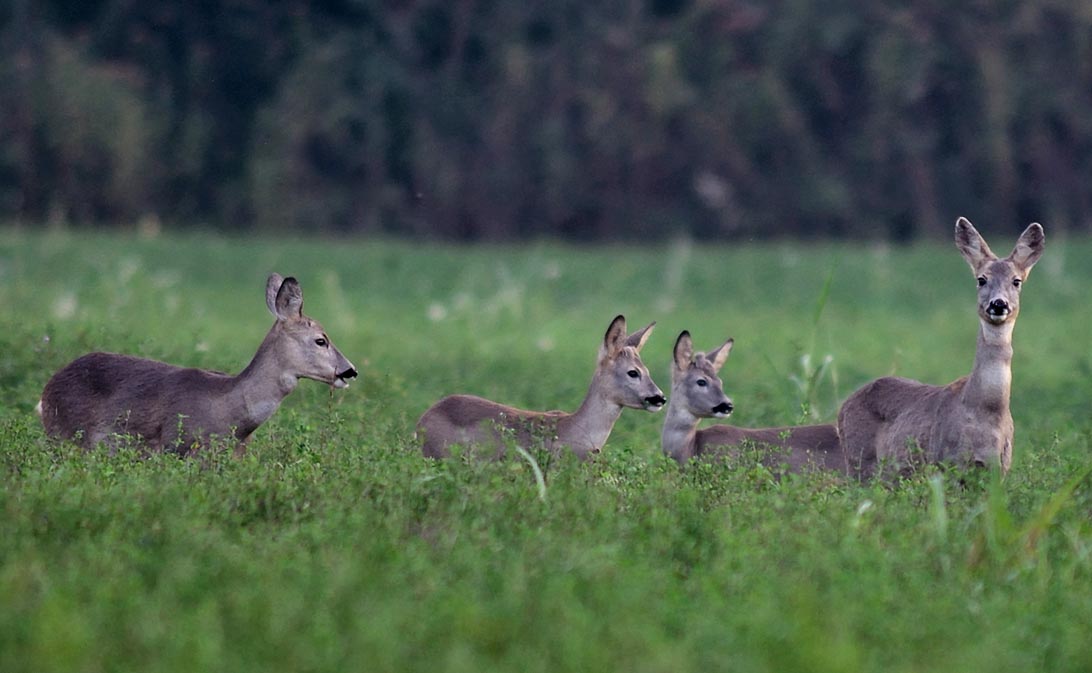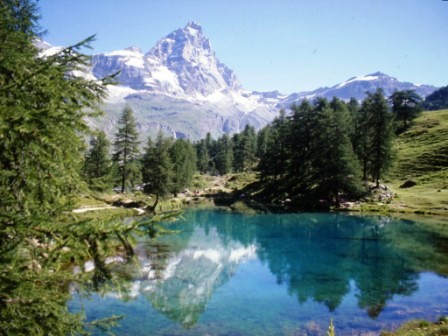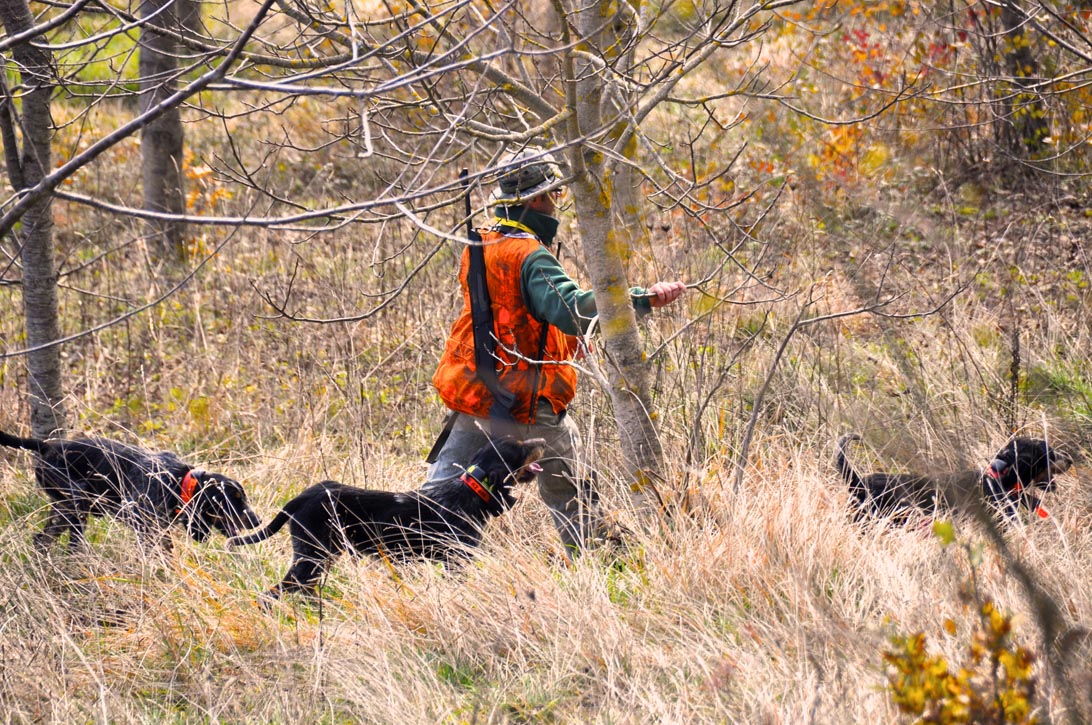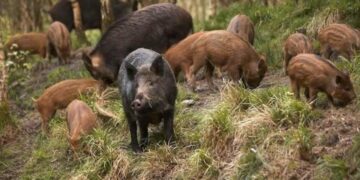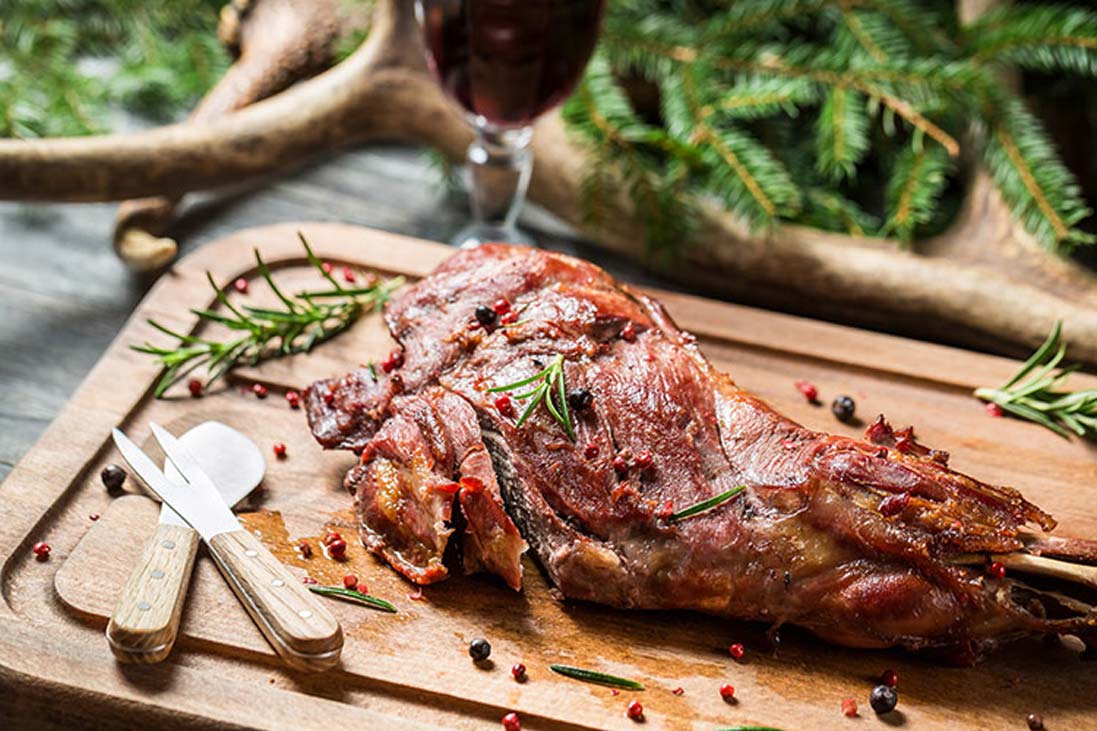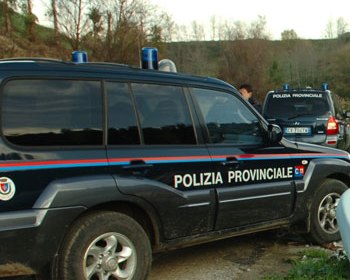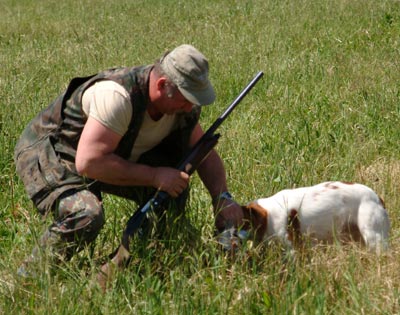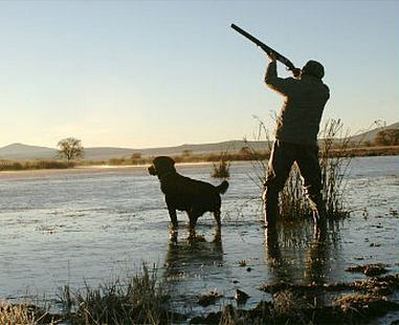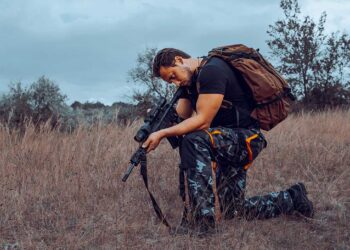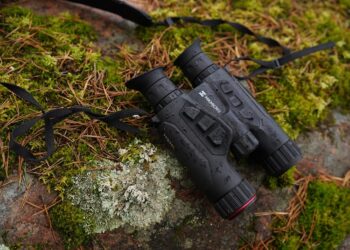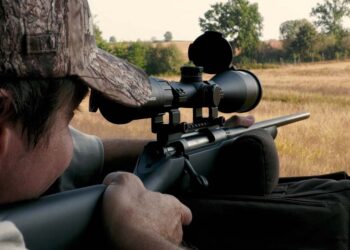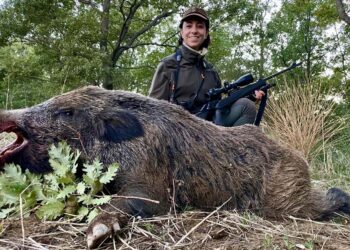 Hunt for Balck Grouse: They say - and it is true - that in the mountains it is good because we seem to be closer to the sky. The black grouse (which we like to call the black grouse) thinks so too when it chooses its singing arena and its habitat at the edge of the tree vegetation. Since hunting this splendid grouse is the one that is most connected to hunting in the plains, it is important to know the lesser known aspects of black grouse, and the spectacular differences that exist compared to lowland pheasants.
Hunt for Balck Grouse: They say - and it is true - that in the mountains it is good because we seem to be closer to the sky. The black grouse (which we like to call the black grouse) thinks so too when it chooses its singing arena and its habitat at the edge of the tree vegetation. Since hunting this splendid grouse is the one that is most connected to hunting in the plains, it is important to know the lesser known aspects of black grouse, and the spectacular differences that exist compared to lowland pheasants.
Text and photos by Riccardo Camusso and Moreno Pellegrin - Article extracted from Diana
The hunter knows that it is not the shotgun that fuels our passion
For a mountain hunter, the natural spectacle that black grouses stage with red caruncles stretched over their eyes, represents a spring appointment that is impossible to give up, no matter if with a shotgun or a digital camera applied at length. Once again, we leave the house late at night. The black arena awaits us, and we know that we must be there at least an hour before sunrise. After many surveys, we have located a good singing arena, dominated by a large male, but we have not yet made a personal "census" on the consistency of grouses in this territory located at the extreme limit of the arboreal vegetation. 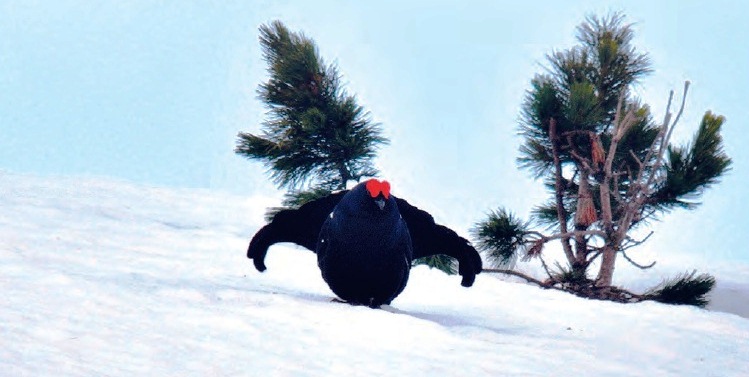 Today we are without a gun. Black grouse is not hunted here in spring. Like many year-round hunters, we have the trusty digital camera and the long. The absence of the rifle does not affect us too much: the suggestions of this natural spectacle that tears us out of bed at night are a tacit appointment for when the camera memory card will be replaced by a 12 gauge cartridge. The desire to know all the aspects of this wild that lives at high altitude, close to the sky, (not as we have seen in the steppes of the Great North of Europe, or in Mongolia), literally puts wings on our feet. It's freezing cold. We are in late spring; from the sky falls a light sleet that reaches to the bones. As soon as the light before dawn allows us to see, the lenses of the binoculars scan every corner of the black territory. It took a lot of exits - including last year's - to find this crowing arena, but we haven't pinpointed the exact spot where roosters will perform in the fighting rituals. For this reason, before entering the scene, we prefer a wide-ranging exploration. We want to understand well. A few minutes pass. The light begins to defeat the dark. The peaks of the mountain are tinged with pink, even in the mist of the valley floor. In the reticle of the binoculars, the first black enters, unmistakable even if black like the shadows of the low bushes. There are also small fir trees that sprout from deep snow, but the shape of the grouse is burned into our mind: it is impossible to confuse it with anything else, or with choughs.
Today we are without a gun. Black grouse is not hunted here in spring. Like many year-round hunters, we have the trusty digital camera and the long. The absence of the rifle does not affect us too much: the suggestions of this natural spectacle that tears us out of bed at night are a tacit appointment for when the camera memory card will be replaced by a 12 gauge cartridge. The desire to know all the aspects of this wild that lives at high altitude, close to the sky, (not as we have seen in the steppes of the Great North of Europe, or in Mongolia), literally puts wings on our feet. It's freezing cold. We are in late spring; from the sky falls a light sleet that reaches to the bones. As soon as the light before dawn allows us to see, the lenses of the binoculars scan every corner of the black territory. It took a lot of exits - including last year's - to find this crowing arena, but we haven't pinpointed the exact spot where roosters will perform in the fighting rituals. For this reason, before entering the scene, we prefer a wide-ranging exploration. We want to understand well. A few minutes pass. The light begins to defeat the dark. The peaks of the mountain are tinged with pink, even in the mist of the valley floor. In the reticle of the binoculars, the first black enters, unmistakable even if black like the shadows of the low bushes. There are also small fir trees that sprout from deep snow, but the shape of the grouse is burned into our mind: it is impossible to confuse it with anything else, or with choughs. 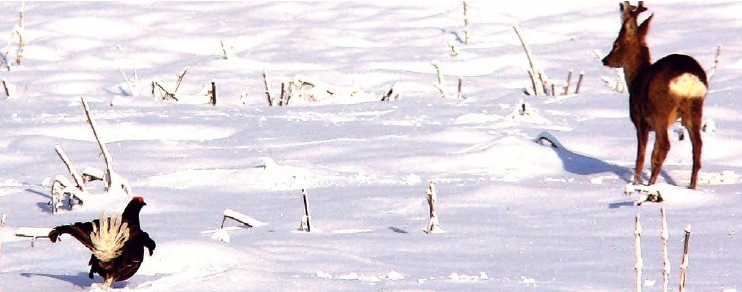 And he! We want to enter the scene, trying to shorten the distance, but we prefer that he be the one to play the first card. Our goal today is to verify which group of trees will be the backdrop for the fighting. If, as in the past few days, he chooses (at least a couple of times) the larch island in a small hollow in the ground, it will mean that the central point of the arena is that. Always the same, season after season. It is a game of chance. The black does not leave the area. Surely he sees us, lurking, but he has other more important things to do. We are in the season of mating and red caruncles. It almost seems that he doesn't want to find out his cards right away, not occupying the arena ahead of time. Here he will "quarrel" until the sun rises. Neck extended high, tail spread like a lyre, great flapping of wings, swollen neck and feather beard under the raised chin. Then, when the day is done, everything will be postponed to the next day. The law of the arena is this; the scene played by the blacks always lasts a short time, no more than a couple of hours. Once again, while we spy on the moves of the black, we "anthropize" the wild animals, trying to understand what leads our black to choose one point of the terrain rather than another. So let's discuss if it can be that secluded and peaceful group of larch trees, or the edge of the wood on our left. Or the snow-covered stony ground where the black stands at this moment, silent. What we need to understand, as always, is where the females are (or will be): even among black grouse, females drive the world. As if to answer our clumsy hypotheses, the black takes off (for no apparent reason) and glides with outstretched wings towards the "island" of the larch trees, almost passing overhead. The dances begin!
And he! We want to enter the scene, trying to shorten the distance, but we prefer that he be the one to play the first card. Our goal today is to verify which group of trees will be the backdrop for the fighting. If, as in the past few days, he chooses (at least a couple of times) the larch island in a small hollow in the ground, it will mean that the central point of the arena is that. Always the same, season after season. It is a game of chance. The black does not leave the area. Surely he sees us, lurking, but he has other more important things to do. We are in the season of mating and red caruncles. It almost seems that he doesn't want to find out his cards right away, not occupying the arena ahead of time. Here he will "quarrel" until the sun rises. Neck extended high, tail spread like a lyre, great flapping of wings, swollen neck and feather beard under the raised chin. Then, when the day is done, everything will be postponed to the next day. The law of the arena is this; the scene played by the blacks always lasts a short time, no more than a couple of hours. Once again, while we spy on the moves of the black, we "anthropize" the wild animals, trying to understand what leads our black to choose one point of the terrain rather than another. So let's discuss if it can be that secluded and peaceful group of larch trees, or the edge of the wood on our left. Or the snow-covered stony ground where the black stands at this moment, silent. What we need to understand, as always, is where the females are (or will be): even among black grouse, females drive the world. As if to answer our clumsy hypotheses, the black takes off (for no apparent reason) and glides with outstretched wings towards the "island" of the larch trees, almost passing overhead. The dances begin!
A duel that looks like a dance
It is difficult to say what black brings - every year - to this precise point of its territory. The hypothesis that we build in our heads evaluates all the favorable elements: the water that flows near the larches; the privacy guaranteed by the slight hollow of the land; the large free spaces of tall vegetation around; the blueberries that will sprout as soon as the snow goes away; the limited number of trees, sufficient to shelter the place from prying eyes but not too thick to prevent a good panoramic view; and other elements that escape our imagination. Yes, because the black in love must have the whole situation in hand; he must be able to see what is happening around him well and control the arrival of any rivals; he must have a couple of good trees on whose branches the females take refuge and where he rests between rounds; a slightly sloping «ring» to always stay at the highest point compared to rivals; the possibility of explaining to the wind all the beauty of its lyre tail and intimidating rivals; an elevated point where you can perform the funny hops at the top; an exposure to the wind that allows to bring out and hear the whistle with which its dominance is sanctioned; a more secluded point where to carry out one's reproductive duty, when all rivals will be expelled from the arena; and much more. This year, however, there is something different. 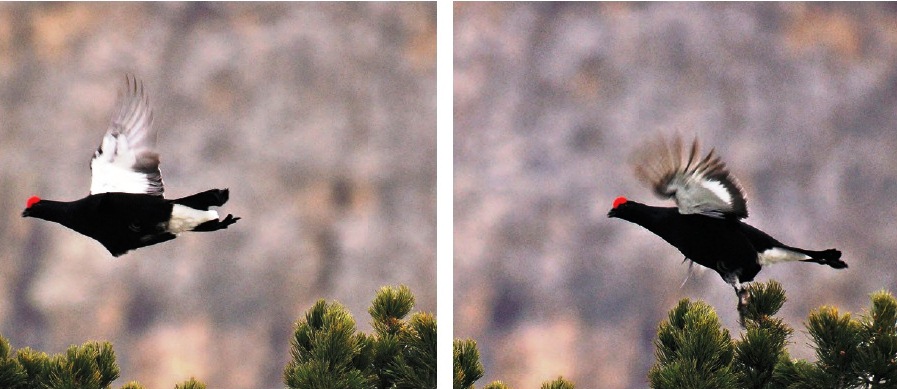 We have approached the larch island, and we can see (and photograph) all of what is happening well. Our black is alone. A single rival overlooks the arena for a few minutes, but is immediately driven out. The expected dialogue becomes a monologue. As befits a first actor. We like to think not of rarefaction of this species, but of the fact that our black friend is so strong and powerful that all the rivals around him fear him to the point of not even showing up in the arena. Furthermore, he performs this monologue with such force that - perhaps - no one dares to challenge him to a duel. This magic, which is repeated every year, always fascinates us and allows us to appreciate one of the most interesting wilds of our mountains. Of course: the black grouse has only the name in common with its distant relative of the plains, but it is worth getting to know it better. In Italy, since hunting by singing is prohibited, hunting methods - with pointing dogs - are transversal to hunting in the plains. Here the affinities end: black grouses that fly in brigades like partridges - we have seen this in Mongolia and Sweden - are not true grouses. In our mountains, the black grouse has a dignity that has nothing in common with the black grouse living in Northern Europe. The hunt is beautiful in every way and at every latitude, but let us say that the killing of a black in our Alps is worth a thousand times more than a game bag of many black grouses hunted like chicken coops on the snowy plains.
We have approached the larch island, and we can see (and photograph) all of what is happening well. Our black is alone. A single rival overlooks the arena for a few minutes, but is immediately driven out. The expected dialogue becomes a monologue. As befits a first actor. We like to think not of rarefaction of this species, but of the fact that our black friend is so strong and powerful that all the rivals around him fear him to the point of not even showing up in the arena. Furthermore, he performs this monologue with such force that - perhaps - no one dares to challenge him to a duel. This magic, which is repeated every year, always fascinates us and allows us to appreciate one of the most interesting wilds of our mountains. Of course: the black grouse has only the name in common with its distant relative of the plains, but it is worth getting to know it better. In Italy, since hunting by singing is prohibited, hunting methods - with pointing dogs - are transversal to hunting in the plains. Here the affinities end: black grouses that fly in brigades like partridges - we have seen this in Mongolia and Sweden - are not true grouses. In our mountains, the black grouse has a dignity that has nothing in common with the black grouse living in Northern Europe. The hunt is beautiful in every way and at every latitude, but let us say that the killing of a black in our Alps is worth a thousand times more than a game bag of many black grouses hunted like chicken coops on the snowy plains.
The choice of the territory
We have often wondered why the grouse choose the most inaccessible areas of the mountain (with the sole exception of the spring arenas). The answer was given to us by the mountaineers who know these areas like the back of their hands. Black grouses prefer the wildest and steepest stretches of the mountain, where the roots of the trees are hardly able to deepen, just to defend themselves from predators (and hunters) and be able to reproduce with relative success. According to the shepherds, the black grouse (object of uncontrolled hunting in the past) is not at risk of extinction thanks to this type of defense. All this while considering the need that the adult leaders have to take the new ones to the comfortable pastures of the high moors, thick with rhododendrons, heather and blueberries. 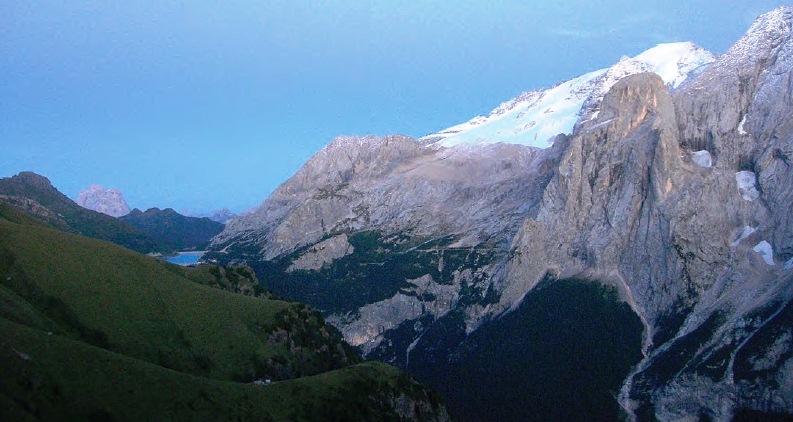 Fortunately, hunters are not exterminators (as we want to paint them): black grouse hunting - especially for females - is prohibited in any territory where the density is drastically reduced. However, we have also witnessed situations that are difficult to interpret: in an area extremely suitable for black grouse, for example, with large expanses of rhododendrons, the rarefaction of the species has led to a closure of hunting for ten years. When it reopened, we all thought we were going to meet black grouses like in a hunting reserve; instead, the situation remained "frozen", as it was ten years earlier. We like to think that the law of Nature and the survival instinct are far better than the laws of man. A further confirmation comes from the fact that the habitat of the grouse - today - has gradually risen: under the limit of the arboreal vegetation and / or at altitudes below 2.000 meters it is very difficult to meet it or locate its singing arena.
Fortunately, hunters are not exterminators (as we want to paint them): black grouse hunting - especially for females - is prohibited in any territory where the density is drastically reduced. However, we have also witnessed situations that are difficult to interpret: in an area extremely suitable for black grouse, for example, with large expanses of rhododendrons, the rarefaction of the species has led to a closure of hunting for ten years. When it reopened, we all thought we were going to meet black grouses like in a hunting reserve; instead, the situation remained "frozen", as it was ten years earlier. We like to think that the law of Nature and the survival instinct are far better than the laws of man. A further confirmation comes from the fact that the habitat of the grouse - today - has gradually risen: under the limit of the arboreal vegetation and / or at altitudes below 2.000 meters it is very difficult to meet it or locate its singing arena.


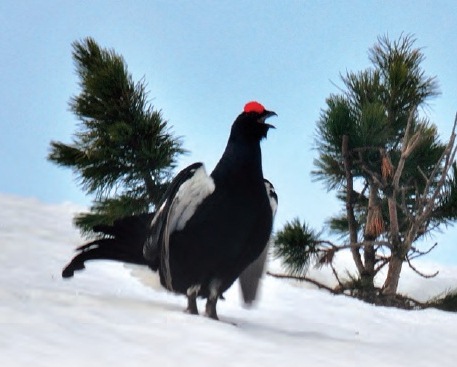 Hunt for Balck Grouse: They say - and it is true - that in the mountains it is good because we seem to be closer to the sky. The black grouse (which we like to call the black grouse) thinks so too when it chooses its singing arena and its habitat at the edge of the tree vegetation. Since hunting this splendid grouse is the one that is most connected to hunting in the plains, it is important to know the lesser known aspects of black grouse, and the spectacular differences that exist compared to lowland pheasants.
Hunt for Balck Grouse: They say - and it is true - that in the mountains it is good because we seem to be closer to the sky. The black grouse (which we like to call the black grouse) thinks so too when it chooses its singing arena and its habitat at the edge of the tree vegetation. Since hunting this splendid grouse is the one that is most connected to hunting in the plains, it is important to know the lesser known aspects of black grouse, and the spectacular differences that exist compared to lowland pheasants.